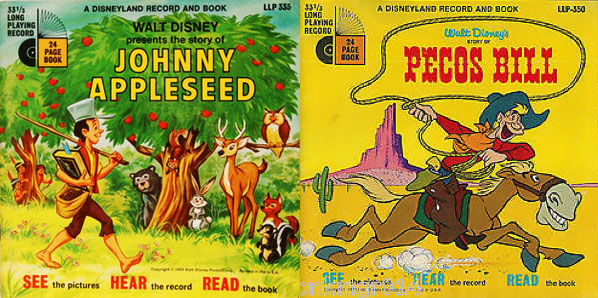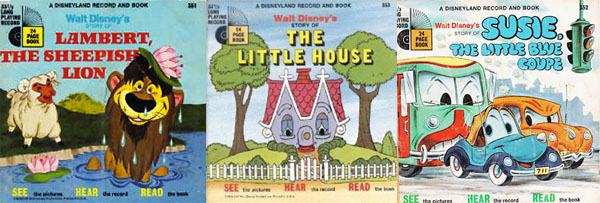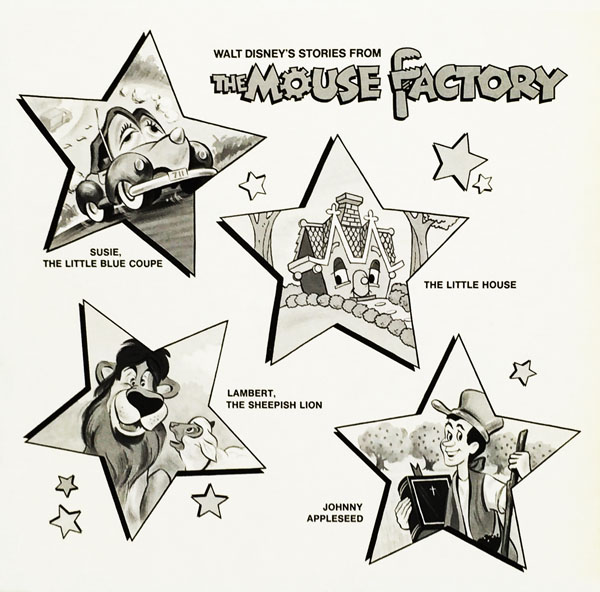With the first complete Silly Symphonies soundtrack vinyl box set on the horizon, let’s see why, 29 years ago, a Disneyland LP called itself “Silly Symphonies” when it wasn’t.

WALT DISNEY’S SILLY SYMPHONIES
8 Stories in Song
Disneyland Records DQ-1333 (12” 33 1/3 RPM LP / Mono)
Reissued on iTunes (2000)
Released in 1971. Executive Producer: Jimmy Johnson. Producer: Camarata. Running Time: 25 minutes.
Vocalists: Katie Briggs, Jeromy Stuart, Robie Lester.
Songs: “The Bremen Town Musicians”, “Lonely for My Love (Rapunzel’s Song)”, “Willie the Whale”, “Gingerbread Man”, “Little House, Little House”, by Tutti Camarata; “Susie, the Little Blue Coupe” by Buddy Ebsen; “Lambert, the Sheepish Lion” by Eddie Pola, George Wile; “Johnny Fedora and Alice Blue Bonnet” by Allie Wrubel, Ray Gilbert.
There was never a bonafide, complete Disneyland “Silly Symphonies” soundtrack album collection until this year — a boxed set of vinyl LP’s, available for preorder this week at the D23 Expo:
But back in 1971, another album was released just before Leonard Maltin’s The Disney Films helped change the course of Disney historianism. Among the incalculable bits of knowledge the book imparted was evidence that not a single song on this album represents a Walt Disney Silly Symphony cartoon, and some of them have no connection to any Disney animation, though one is based on a story that would be animated by Disney many years later.
The saga of these songs is very convoluted, but it starts with the ugly truth about any entertainment project: budget. By the late ’60s, Disneyland and Buena Vista Records were releasing fewer new titles and repackaging earlier ones (as were all the other major and independent children’s record labels). Disney’s “See…Hear…Read” little LP and read-along book sets were always dependable sellers. They also were produced at a low cost because one side of the record featured a reading of the book with no music or sound effects; side two contained one or two (sometimes three) songs.

To keep the pot boiling, you have to have new or newly repackaged merchandise to keep retailers happy, so in the mid-‘60s, Jimmy Johnson hit upon the idea of releasing children’s stories in this read-along series with little or no connection to Disney films. Tutti Camarata, as the artists and repertoire director, brought in small combos, a few singers and songwriters to create simple tunes, a few of which never turned up on LP albums.
In the early ’70s, Walt Disney Productions put a syndicated half-hour TV series into production in the early ’70s called The Mouse Factory. Each episode focused on one subject with a guest host to introduce costumed Disney Characters and related cartoons (e.g. Annette Funicello’s installment was about penguins, so the cartoon was The Penguin Who Hated the Cold). The Mouse Factory depicted the characters clocking in for work at the studio every day to go about their business creating magic that’s made for you and me.

The shows were shot on film, and bore a passing resemblance to the Oscar-winning short, It’s Tough to Be a Bird and, even more so, Dad, Can I Borrow the Car? These films combined assorted live action segments with snippets of new and existing animation, both were directed by Ward Kimball – and The Mouse Factory was too. Kimball dug into the animation library, building episodes around specific subjects. The series did not receive an extensive release – it was syndicated and not seen in many cities until The Disney Channel started rerunning it in the ’80s.
The records based on The Mouse Factory, however, were everywhere — even if the series was not seen where they were being sold. Among them were three Mouse Factory 7-inch song records starring Mickey, Donald and Goofy and a 12-inch LP, The Mouse Factory Presents Mickey and His Friends, featured previously released material from various Mickey Mouse Club and Disney Character albums, very much like its sister album, Mickey Mouse and His Friends.

What has this got to do with the bogus Silly Symphonies album? It relates to the songs that were made for the read-alongs. Some of these book-and-record sets were based on segments from Disney “package” films of the ’40s: The Whale Who Wanted to Sing at the Met and Johnny Fedora and Alice Blue Bonnet from Make Mine Music (1947); Johnny Appleseed and Pecos Bill from Melody Time (1948).
Others came from Disney “special” shorts with no designated category: Susie, the Little Blue Coupe, Lambert, the Sheepish Lion and The Little House. And then there were a few children’s stories with no direct Disney film connection unless we really stretch for one. Bremen Town Musicians was a Disney Laugh-O-Gram in 1923. Rapunzel became Disney’s Tangled many decades later. “The Gingerbread Man” has a loose association to Cookie Carnival — and it is indeed a Silly Symphony cartoon — but look how far we had to stretch to make that connection!

The other unusual thing about this non-Silly Symphonies album is the style of its music. The arrangements are very much like the pop and folk of the early ’70s, which doesn’t seem unusual now, but was slightly jarring to listeners used to the jaunty, peppy little bands or warm orchestras of most Disney records up to that time. This album features by a Carole King-style piano, a groovy synthesizer (think Electric Company) and the versatile young Katie Briggs and Jeromy Stuart, who also appeared on Disney’s more “kiddie-style” Rubber Duckie and Other Songs from Sesame Street LP.
One exception is “Gingerbread Man”. Sung by a speeded-up Robie Lester with sparse synthesized accompaniment, it’s an earworm that doesn’t play well when edited into one track as it is on this album. It was originally released in 1968 on its own LP and was broken into pieces to fit around Lester’s narration. (It should also be noted that Jeromy Stuart’s version of the Pecos Bill song did not appear on any LP albums.)
The most startling track on the album is Susie, the Little Blue Coupe. It’s without doubt the most hard-driving R&B sound to appear of a Disney record until the late 1980s. Katie Briggs throws everything she has into an Aretha Franklin twist on what is actually a ditty written by Buddy Ebsen. (We did a Spin about Decca’s Susie and Little House records a few months back.)
GIVE A LITTLE LISTEN
“Lonely for My Love (Rapunzel’s Song)” – Katie Briggs
Katie Briggs’ range is exemplified by the completely different approach she gives this lovely ballad with music and lyrics by Tutti Camarata. It’s the most “traditionally” arranged song on the album, yet it still has that “madrigal” sound that suggests the early ’70s music of back-to-nature youth.

STORIES FROM THE MOUSE FACTORY
Disneyland Records Storyteller Series ST-3808 (33 1/3 RPM LP / Stereo)
Released in 1972. Executive Producer: Jimmy Johnson. Producer: Camarata. Running Time: 25 minutes.
Voices: Robie Lester (Narrator); Lois Lane (Narrator); Dennis Day (Johnny Appleseed, Old Settler); Katie Briggs, Jeromy Stuart, Robie Lester (Vocalists).
Stories: “Susie, the Little Blue Coupe”, “The Little House”, “Lambert, the Sheepish Lion”, “Johnny Appleseed”.
Songs: “Susie, the Little Blue Coupe” by Buddy Ebsen; “Little House, Little House”, by Tutti Camarata; “Lambert, the Sheepish Lion” by Eddie Pola, George Wile; “The Lord is Good to Me”, “Pioneer Song”, “The Apple Song” by Kim Gannon, Walter Kent.
 This album makes all the pieces fit together. All four of these stories were shown as Disney cartoons on The Mouse Factory, and all four are edited narrations from 7” Disneyland read along sets.
This album makes all the pieces fit together. All four of these stories were shown as Disney cartoons on The Mouse Factory, and all four are edited narrations from 7” Disneyland read along sets.
A few notable things distinguish this album. Even though the cover and record label do not indicate it, two sections are in full stereo: Susie, the Little Blue Coupe and the three Johnny Appleseed songs.
Children’s records waivered between mono and stereo with confusing inconsistency in the ’60s and early ’70s. Lots of recordings were made in stereo but were never released as such. It’s a shame because, in the case of “Susie”, there is no comparison between the mono and stereo range, which offers all the instrumentation clear and distinct.
If you read the above album credits, you might have wondered if one of the narrators really is Superman’s lady friend. This “Lois Lane” was a popular British singer who made appearances on TV, radio and nightclubs. Sometimes BBC Radio 4 Extra runs vintage variety shows in which she performs. She simply liked the name Lois Lane in the Superman comics and made it her stage name. She recorded several Disney read-alongs, but not as much as the all-time record holder, Robie Lester.
GIVE A LITTLE LISTEN
“The Lord is Good To Me” – Dennis Day
This is a fresh studio rendition of the tune; it is not from the soundtrack. It’s a shame that the 1963 Disneyland story album of Johnny Appleseed was not released in stereo, as you can hear how pleasant the two channels make this song shine. It is possible that the whole recording was not in stereo as, on the album, “The Apple Song” snaps into mono right directly following this song. It was great that Dennis Day came into the studio again to record this so many years after he did the role in Melody Time.


 GREG EHRBAR is a freelance writer/producer for television, advertising, books, theme parks and stage. Greg has worked on content for such studios as Disney, Warner and Universal, with some of Hollywood’s biggest stars. His numerous books include Mouse Tracks: The Story of Walt Disney Records (with Tim Hollis). Visit
GREG EHRBAR is a freelance writer/producer for television, advertising, books, theme parks and stage. Greg has worked on content for such studios as Disney, Warner and Universal, with some of Hollywood’s biggest stars. His numerous books include Mouse Tracks: The Story of Walt Disney Records (with Tim Hollis). Visit 





















































Syndicated? I could swear I remember watching this show (Mouse Factory) on NBC!!
The Mouse Factory was one of many series (including Hanna Barbera’s Wait Till Your Father Gets Home) created to fill a need in first run syndication programming when the FCC instituted the Prime Time Access Rule in 1970.
The networks (CBS, NBC and ABC) had to give up a half hour of traditional “prime time” – usually the 7:30-8pm slot – and return that time to the local stations. This created a need for new game shows and other programs. Just like you where I grew up, in the New York area, The Mouse Factory ran on NBC.
I remember when the prime-time access rule went into effect. The FCC expected the half hour to be filled with local-interest programming. Instead, the TV stations took the cheap way out and bought syndicated programming. I remember lots of game shows on at 7:30PM (like Jerry, I grew up in the New York area; I still live there).
The prime time access rule required only the country’s largest markets to air original, first-run programming during that half-hour, resulting in a flurry of game shows, original sitcoms like DUSTY’S TRAIL and OZZIE’S GIRLS, and programs like THE MOUSE FACTORY. Smaller markets, such as where I grew up, didn’t have to do that, so for those stations, “prime time access” became just another time slot in which they could schedule I LOVE LUCY reruns.
Seems like the perfect excuse. Have to see what my town was running around that time.
In Pittsburgh, Pa. our ABC affiliate ran a locally produced “Bowling For Dollars” show where viewers had a chance to win money based on what the local bowlers bowled.
Our CBS affiliate was a “Group W” (Westinghouse) station and ran the local version of “Evening Magazine”.
The NBC affiliate ran syndicated game shows.
If I recall, “Wait ’till Your Father Gets Home” (HB) , “Where’s Huddles” (HB), and “Mouse Factory” (WD) ran at 7:30pm on the CBS affiliate after Evening Magazine. Live action “Ozzie’s Girls” and “Dusty’s Trail” filled out the week. Later “The Muppet Show” appeared.
Because I have nothing better to do, I looked up a random day in the summer of ’73. here’s what was being played in my town every night at 7:30…
The stations used are WTOL (11, a CBS affiliate, owned by Liberty Insurance for a number of decades), WSPD (13, an NBC affiliate at the time, once owned by the Storer Broadcasting Co.) and WDHO (24, ABC, and at one time the flagship for America’s short-lived fourth TV network called The Overmyer Network).
MON
11 Hollywood Squares
13 Truth or Consequences (also played on the next four days)
24 I’ve Got A Secret (local version of Bowling for Dollars aired a half-hour before)
TUE
11 The Price is Right
24 The Adventurer
WED
11 Police Surgeon
24 Let’s Make A Deal
THU
11 The Parent Game
24 Circus
FRI
11 You Asked For It
24 Wait Till Your Father Gets Home
SAT
11 Baseball (CBS network broadcast of Baltimore vs. Detroit)
24 Stand Up and Cheer
Annette also hosted a Mouse Factory episode devoted to Mickey Mouse. It featured cartoons like The Barnyard Broadcast.
I remember seeing that Silly Symphonies album at the local grocery store – even at that young age I knew that Silly Symphonies predated the songs on the album.
i was never a fan of “The Mouse Factory”.
I agree with my art instructor at the time after he watched a couple of episodes in that we rather watch a half hour of the original Disney shorts than butcher them up into this mess…
Well, I honestly don’t see much of a difference between that “The Bugs Bunny Show” in the way they edit their shorts.
What I’m wondering was who did the arrangements of “Whistle While You Work” (which was played in the style of Spike Jones) and the saxophone quartet version of “Minnie’s Yoo Hoo” which was played in the end credits of The Mouse Factory and that version of Minnie’s Yoo Hoo was also played in Televisa’s Chesprito show.
Greg:
Another great post! I’ve got to get my own copy of the Silly Symphonies set!
The Rapunzel cut was okay,but it didn’t sound like Disney to me! The Johnny Appleseed cut with Dennis Day,on the other hand,sounded just like classic Disney! Thanks for sharing!
Now get those restored Silly Symphonies soundtracks married to hi-def transfers of the cartoons, put ’em on Blu-Ray and you got yourself a customer.
This, exactly.
This is the thing that baffles me about both Disney Consumer Products and their customers. Why, in 2015, would you only have the cartoon soundtracks WITHOUT THE CARTOONS? And only available on the fad format du jour? Talk about the tail wagging the dog!
I’ve been collecting Disney records for 40 years, and I have no interest in this set whatsoever. But sync up its contents with HD video on Blu Ray? Shutupandtakemymoney.
Well, at least it’s a good idea, even though I wish this was offered on CD too.
Plus, I think it’s sort of dumb complaining about this since Greg is involved here.
“Lois Lane” was also the guitar playing, blonde one of the earlier 1960s British duo The Caravelles, the first girl instrumental and British group to hit the US … RIGHT BEFORE The Beatles! (“You Don’t Have to Be a Baby to Cry“, 1963/64, etc.)
And I also remember seeing that record, when it was originally released, didn’t even know till now that they weren’t the songs “as done” on the cartoon, and found out when Christopher Finch and Leonard Maltin did their respective, individual Disney books, both 1973 (Finch:”The Art of Walt Disney“/Maltin: “The Disney Films“), that Silly Symphonies designated an OLDER GENERATION (1930s) of DISNEY FILMS!! What a disillusionment to a thirteen-year old in ’73-74!!
The days of unknown cluelessness must’ve been staggering!
Love those old Disney read-along book-and-audio sets! Here’s a review I did of one, with me in character as Disney’s Big Bad Wolf, listening to their “Little Red Riding Hood” read-along from 1968…
https://www.youtube.com/watch?v=lfvuz13R6RQ
. My Dad used to buy me those Disney read-along records. There were also eps on Disneyland Records of songs from Disney movies. They weren’t the original versions mostly,although a few times some of the actual movie versions showed up (like Nancy Adams’ recording of ‘Love’ on the Disneyland ‘Songs from Robih Hood’ ep).
Hello Greg
Thank you for this piece,
We just put on the 1971 Lp Silly Symphony’s and freaked out,
What is this strange Disney LP?
You helped clear up the confusion
Love you work
Michael